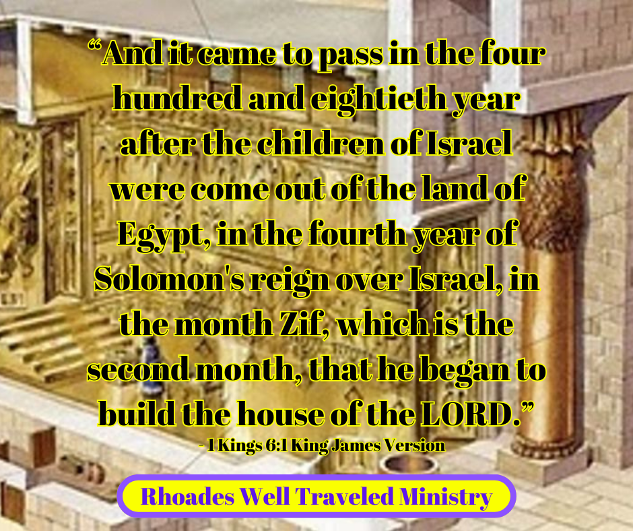GOD'S WORD
▬ The Construction of Solomon's Temple - The Temple of the Lord ▬
January 21, 2024

Reverend Danny Rhoades
Good day Brothers and Sisters. My Daily Devotional is going to be about the construction of Solomon's Temple - The Temple of the Lord.
The construction of the Temple, as depicted in 1 Kings 6:1-7:51 and 2 Chronicles 3:1-4:22, holds immense significance in the history of ancient Israel. This awe-inspiring structure, commissioned by King Solomon, represented the culmination of Israel's longing for a permanent dwelling place for God. The process of building the Temple was a meticulous and grand endeavor, requiring extensive planning, gathering of resources, and skilled craftsmanship. This Devotional
explores the various aspects of the Temple's construction, from Solomon's preparation to the final touches, unveiling its magnificent architecture, symbolic significance, and lasting legacy.
In ancient Israelite society, the Temple held immense significance and played a central role in religious and cultural practices. It served as a sacred dwelling place for God and symbolized the spiritual connection between the divine and the people. The Temple was not only a place of worship but also a hub for communal gatherings, festivals, and sacrifices. Its construction was regarded as a monumental undertaking, reflecting the importance of faith and devotion in the lives of the Israelites.
King Solomon, renowned for his wisdom and wealth, envisioned constructing a magnificent Temple that would surpass any other in glory and splendor. Inspired by his deep reverence for God, Solomon aimed to create a place that would honor the divine presence and serve as a testimony to the greatness of Israel's God. With unwavering determination, he embarked on this ambitious project, sparing no effort in ensuring its grandeur and beauty.
To fulfill his grand vision, Solomon undertook extensive preparations to gather the necessary materials for the Temple's construction. He sought out the best quality of cedar, cypress, and stone, both from within Israel and through trade with neighboring regions. Precious metals like gold and silver were procured in abundance, ensuring that no expense was spared in creating a truly majestic edifice.
Recognizing the importance of skilled craftsmanship, Solomon meticulously handpicked the most talented artisans and craftsmen to work on the Temple. These individuals possessed expertise in various disciplines, including carpentry, stonemasonry, and metalworking. Their skills and dedication would be pivotal in translating Solomon's vision into reality, as they labored to create intricate designs and exquisite decorations for the Temple.
Before the construction could commence, meticulous planning and design were undertaken. Architects and engineers worked closely with Solomon to develop detailed blueprints that would guide the construction process. These plans took into account the structure's dimensions, the placement of various chambers and rooms, and the intricate details of its architecture. Every aspect of the Temple's design was carefully considered to ensure its functionality, beauty, and adherence to the divine vision.
With the preparations complete, the construction of the Temple commenced in earnest. The first step involved clearing the designated site and preparing the foundation. Undulating terrain and natural obstacles were overcome, making way for the solid groundwork upon which the Temple would be erected. This stage required meticulous attention to detail, ensuring a stable and secure foundation that would withstand the test of time.
As the foundation took shape, the construction workers diligently raised the walls of the Temple using carefully cut and fitted stones. The process required precision, as the stones had to align perfectly to create a seamless structure. Massive beams, meticulously crafted by skilled artisans, were carefully installed, forming the framework of the Temple and providing the necessary support for its walls and roof. With each stone and beam put in place, the Temple began to take form, bringing Solomon's vision closer to reality.
The construction of the Temple was not without its challenges. From the logistics of transporting massive stones to overcoming technical hurdles, Solomon and his team faced numerous obstacles along the way. However, their determination, resourcefulness, and unwavering faith guided them in finding innovative solutions. Through diligent problem-solving and careful execution, they navigated through every challenge, ensuring that the construction progressed smoothly.
The exterior of Solomon's Temple was a sight to behold, radiating splendor and majesty. Its magnificent walls were adorned with intricate carvings, depicting scenes from Israelite history and religious symbolism. The use of precious metals, such as gold and silver, further enhanced its grandeur and captivated all who beheld it. From a distance, the Temple stood as a testament to Israel's devotion and the glory of their God.
Inside the Temple, a meticulously planned layout reflected the spiritual significance of the space. The Holy of Holies, the innermost chamber, housed the Ark of the Covenant, signifying the presence of God. Surrounding it were various chambers and rooms, designated for specific purposes such as storing sacred artifacts and facilitating rituals. The layout emphasized the distinction between the divine and the mortal, allowing worshippers to approach God with reverence and awe.
Every architectural element within the Temple held profound symbolism. From the grand entrance adorned with ornate pillars to the intricate carvings and engravings that adorned the walls, each detail conveyed deeper meanings. Symbolic representations of nature, history, and divine encounters adorned the Temple, reminding worshippers of their rich heritage and the immeasurable power of their God. The architectural elements not only enhanced the aesthetic appeal but also served as visual reminders of the Israelites' faith and spiritual journey.
With meticulous planning, unwavering devotion, and skilled craftsmanship, the construction of Solomon's Temple began to unfold. This monumental undertaking would leave a lasting legacy, representing the pinnacle of Israelite architectural and religious achievements. The Temple would forever stand as a testament to the Israelites' commitment to their faith and their devotion to their God.
After years of meticulous construction, the momentous day finally arrived when the Temple's construction was complete. The builders put the finishing touches on the interior design and decoration, ensuring that every detail was perfect. The walls were adorned with beautiful tapestries and intricate carvings, reflecting the grandeur of the structure. It was a sight to behold, a true masterpiece of craftsmanship.
One of the most significant moments in the Temple's completion was the preparation of the Ark of the Covenant for its rightful place in the Holy of Holies. The Ark, containing the stone tablets with the Ten Commandments, was carefully carried into the Temple with great reverence and awe. The priests ensured that everything was in order before placing the Ark at the center of the Temple.
With the Temple now ready, a solemn dedication ceremony took place to consecrate this sacred space. King Solomon, accompanied by the priests and Levites, led the people in prayers and sacrifices, seeking God's blessing and presence in the Temple. The atmosphere was filled with reverence and anticipation as the people witnessed this historic event. It was a moment of great celebration and joy, marking the beginning of a new era for Israel.
The Temple was not just a place of worship but also a testament to the artistic skills of its builders. Every corner of the Temple was adorned with exquisite furnishings and decorations. Golden menorahs, intricately designed altars, and magnificent bronze pillars adorned the holy space. The craftsmanship was remarkable, showcasing the finest skills of the artisans involved.
Within the Temple, the Holy of Holies stood as the most sacred area. It housed the Ark of the Covenant and was separated from the rest of the Temple by a thick veil. The stunning beauty of the Holy of Holies was beyond words, emanating a sense of divine presence. It was a place where only the high priest could enter once a year, after undergoing rigorous purification rituals. The Holy of Holies symbolized the closeness of God and His chosen people.
Music and rituals played a crucial role in enhancing the splendor of the Temple. Skilled musicians and singers were appointed to lead the people in worship, creating a harmonious atmosphere. The sounds of harps, lyres, and trumpets reverberated through the Temple, lifting the spirits of all who gathered there. Rituals, such as the burning of incense and the offering of sacrifices, created a sense of sacredness and connectedness with the divine.
The Temple held immense spiritual significance for the Israelites as it was believed to be the dwelling place of God on Earth. It represented the sanctity of God's presence in their midst, a physical manifestation of His covenant with His chosen people. The Temple served as a meeting place between the divine and human, a sacred space where prayers were offered, and sins were atoned for.
Sacrifice and worship were central to the Temple's function. The priests performed elaborate rituals, offering animal sacrifices to seek God's forgiveness and express gratitude. These acts of worship symbolized Israel's commitment to their covenant with God and their desire to maintain a close relationship with Him. Sacrifices were seen as a way to bridge the gap between the human and the divine, a means of seeking reconciliation and restoration.
The Temple reflected the deep bond between Israel and God. Its construction and maintenance were seen as acts of devotion, a tangible expression of their faith and loyalty. The Temple represented the heart of Israel's identity and their unique relationship with God. It served as a constant reminder of their purpose as a chosen people and their responsibility to live according to God's commandments.
The Temple had a profound impact on Israelite religious practices. It became the focal point for worship, drawing people from all over the land to offer sacrifices and seek God's presence. The priests and Levites played a vital role in the Temple's rituals, ensuring that the religious traditions were upheld. The Temple's presence shaped Israelite religious life, influencing their prayer, sacrifice, and festival practices.
Brothers and Sisters, the church today reflects the deep bond between us and God. Its building and upkeep are seen as acts of love, a visible sign of our trust and commitment. The church represents the core of our identity and our special relationship with God. It serves as a constant reminder of our calling as a chosen people and our duty to live according to God's will. The church has a profound impact on our religious practices. It becomes the center of worship, attracting people from all walks of life to offer praise and seek God's face. The pastors and leaders play a vital role in the church's services, ensuring that the religious traditions are maintained. The church's presence shapes our religious life, influencing our prayer, giving, and celebration practices.


Be at peace with God, whatever you
conceive Him to be.
Join us in spreading God's love and compassion to those in need.



